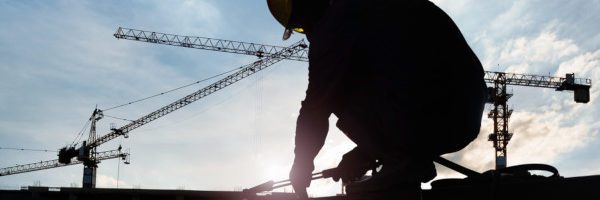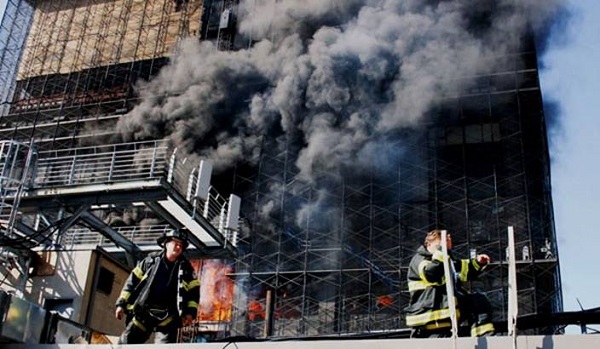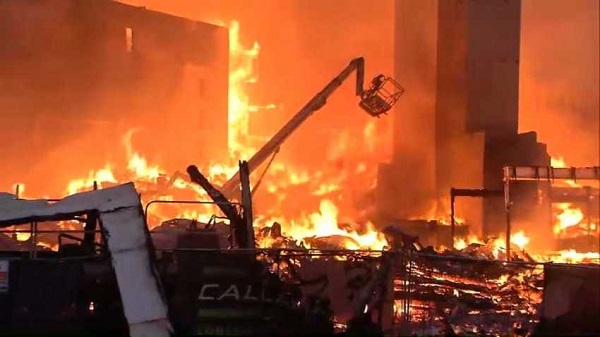NFSA Seeks Clarity About Fire Protection During Construction

Fire protection during construction is vital. What role do sprinklers play?
Numerous dramatic and costly fires highlight the importance of fire safety on construction sites. There were an average of 3,840 fires per year in buildings under construction (about 10 per day) between 2013 and 2017, according to the 2019 National Fire Protection Association (NFPA) report “Fires in Structures Under Construction or Renovation.” Blazes at sites under construction or renovation caused $408 million in direct property damage, 12 civilian deaths, and 101 civilian injuries each year, with construction accounting for the vast majority of property damage (74.5%).
These sites are vulnerable to fire for many reasons. There are plenty of heat and spark sources around, plus a high fuel load. Arson is a risk. And active fire protection systems that include detectors, alarms, sprinklers, and standpipes may not be completed or in service.
Authorities having jurisdiction (AHJs) and building owners are naturally anxious about protecting these sites and bringing fire protection systems online. The National Fire Sprinkler Association (NFSA) shares this impulse; our mission is protecting lives and property by advancing the fire sprinkler concept. And fire sprinklers do have a unique, effective potential to stop or control fires on construction, renovation, and demolition sites.
But fire sprinklers are complex systems subject to diligent installation standards and acceptance testing that enable AHJs, first responders, and the general public to trust that they will function as intended. And right now, there is no clear standard on how to implement fire protection during construction.
What role do sprinklers have to play in protecting these sites? How should systems be implemented? Can we rely on temporary sprinklers that don’t meet all of the requirements of NFPA 13: Standard for the Installation of Sprinkler Systems for being placed into service?
In theory, NFPA 241: Standard for Safeguarding Construction, Alteration, and Demolition Operations (2019 edition) should have all of these answers. But NFPA 241 defers installation issues to NFPA 13, even though many NFPA 13 requirements cannot be met until the late stages of construction or in a completed, functioning building with a certificate of occupancy.
Sprinkler contractors, sometimes directed by AHJs to open sprinkler control valves, worry about their liability and the reliability of their systems under these circumstances. NFSA is pressing for a clarification of the standards to meet this challenge.

The absence of fire safety plans and compliance has serious consequences. Before a cigarette set the building alight in 2007, workers demolishing the Deutsche Bank skyscraper had cut the standpipe and barricaded many means of egress.
Fires spur the call for common sense fire protection during construction
Disastrous construction, renovation, or demolition fires like the Deutsche Bank fire of 2007 and the Waltham apartment fire of 2018 make it clear why NFPA 241 and AHJs push for working fire protection systems on these sites.
In the Deutsche Bank fire, the New York City skyscraper was set ablaze by a smoking worker as it was being dismantled due to damages from 9/11. Two firefighters died in the fire. And subsequent investigations showed that inoperable sprinklers, a cut standpipe, means of egress sealed with wood, and compromised or absent stairway enclosures all contributed to the deaths.

There were no working detection or sprinkler systems to raise the alarm or provide suppression when an arsonist set the Waltham apartment complex ablaze in 2018. Source: NBC Boston
In this video, NFPA Senior Fire Investigator Robert Duval comments on the Waltham fire and the importance of safeguards on construction sites, including putting fire sprinklers in service when practical:
NFPA 241’s construction fire prevention and protection plan
NFPA 241 outlines rules and procedures for protecting construction sites, renovation projects, and demolition sites from fires. The document has legal authority wherever versions of NFPA 1: Fire Code, NFPA 5000: Building Construction and Safety Code, the International Building Code (IBC), or the International Fire Code (IFC) have been adopted into law. One of the most useful parts of NFPA 241 is its requirement for a fire safety program that includes many precautionary measures.
NFPA 241’s fire safety programs
The fire safety program specified in NFPA 241 is fundamental. In numerous jurisdictions, authorities won’t issue building permits without one.
Fire safety programs lay out precisely what the owner should do to keep their construction site from going up in flames. They address common causes of construction fires, such as cooking equipment, electrical and heating devices, arson, and torches, burners, and soldering irons. Preventative measures like security and good housekeeping (7.1.2), hot work permits (7.2.4.3), and self-inspections (7.2.4.4) are designed to ensure that fires don’t start.
Plans also include detection and suppression measures so that a quick and effective response can be mounted if a fire breaks out. These measures include security and fire watch (7.2.5), on-site fire brigade (as applicable; 7.1.2), pre-fire plans with the fire department (7.2.3), quick and reliable communication procedures and systems (7.4), road access (7.5), firefighting capabilities like hydrants (7.5.6), and the implementation of standpipes (7.6).
Critically, a fire safety program must address fire protection systems, specifically the “installation of new fire protection systems as construction progresses” or the “preservation of existing fire protection systems during demolition” (7.1.2). This, of course, includes standpipes, alarms, and fire sprinkler systems.
The place of fire sprinklers in NFPA 241 fire safety programs
All fire protection systems play a role in site safety, but sprinklers have unique potential—no other procedure or system gets water on a fire faster and has as much ability to control a blaze. To this end, NFPA 241 says that sprinklers should be brought into service to protect buildings “as soon as practicable.” But the standard also specifies that this installation should follow the rules outlined in NFPA 13.
The National Fire Sprinkler Association appreciates NFPA 241’s intent for deploying fire sprinklers on construction sites. But the lack of direction in NFPA standards on how to implement a “temporary” sprinkler system can put fire sprinkler professionals in a difficult situation. They are often caught between the mandate to fully comply with NFPA 13 and the direction to implement a temporary system on a construction, demolition, or renovation site.
The conflicting direction in NFPA 241
The discord between compliance and protection is evident in these sequential sections of NFPA 241:
8.7.3.1 If automatic sprinkler protection is to be provided, the installation shall be placed in service as soon as practicable.
8.7.3.2 The details of installation shall be in accordance with NFPA 13.
How can sprinkler contractors reconcile this guidance?
To avoid potential code violations and liability, contractors may assume that “as soon as practicable” means “as soon as construction is complete and a certificate of occupancy is issued.” And, in many cases, they would be justified in doing so.
Some NFPA 13 requirements simply cannot be met while the building is under construction. For example, adequate freeze protection might not be available. Nonmetallic pipes might still be exposed, contrary to NFPA 13 and their listing. Compartmentation, including firestops and firewalls, might not be ready—and these passive fire protection measures often work in concert with sprinklers to control fires. The list goes on.
But only placing sprinklers in service upon building completion deprives structures of protection while they are most vulnerable. And there are certain scenarios where sprinklers are indeed practical. For example, in a project renovating a 10-story building where work is done floor by floor, working systems can be turned on in phases.
Further, AHJs want fire sprinklers on sites. And, for them, “as soon as practicable” may mean, “as soon as the sprinkler system can get water on a potential fire.” NFPA 241 offers justification for this view:
7.9 Temporary Protection During Construction, Alteration, or Demolition. During construction, alteration, or demolition, the use of temporary fire sprinkler protection approved by the AHJ shall be permitted as supplemental protection.
This section allows sprinkler systems that do not meet all NFPA 13 requirements for acceptance testing to be deployed temporarily, though only as supplemental protection. The context for this is provided in A.7.9 of NFPA 241, which argues that “there is no harm in allowing this additional safety feature” because sprinklers are “supplemental”—one safeguard among many on a construction site.
In reality, however, some AHJs require sprinkler systems to be deployed quickly and treat them as essential—not supplemental. This is one area where potential trouble lies. Worries remain about overly relying on systems that haven’t been acceptance-tested and aren’t fully compliant with NFPA 13. What does an acceptable sprinkler system look like in such a case? And who bears the liability if it fails?
“As sprinkler contractors, we usually only know one way of doing things, and that’s code compliance. And code compliance includes compliance with NFPA 13,” explains Michael Joanis, NFSA’s director of contractor services. “That’s our major issue—how do we implement something that’s not compliant with those standards, what are the liability issues, and is it even going to work?”
AHJs, owners, the public, and fire responders need reliable sprinklers on construction sites. But contractors need more explicit guidance on deploying them.
NFSA’s goal: clarify the standard for fire sprinklers on construction, renovation, and demolition sites
Improving the model codes and standards is a core part of NFSA’s mission to improve fire safety and promote the use of fire sprinklers. Clear codes and standards lead to functional, reliable systems that can do their job to protect lives and property.
Buildings undergoing construction, renovation, and demolition are more vulnerable to fire than completed structures and certainly need fire protection—aggregated data and examples of disastrous fires make that abundantly clear. And fire sprinklers can be a powerful solution alongside preventative measures and other systems like standpipes, detectors, and alarms.
But NFPA 241 is simply not explicit on how and when sprinklers should be deployed, and to what extent the requirements of NFPA 13 can be modified. On the topic of fire sprinklers, NFPA 241 makes three points:
- Sprinkler systems should be placed in service as soon as practicable.
- Sprinkler systems should be installed following NFPA 13.
- Temporary sprinkler systems are permitted to protect construction sites.
Items 1 and 3 can conflict with item 2. And the definition of “practicable” is open to interpretation by designers, AHJs, and contractors, creating concerns for sprinkler contractors about liability and reliability. To address this issue, the standard should ideally be clarified to provide more specific guidance.
“NFSA’s position is that there’s really no standard for temporary systems,” says Joanis. “So, the concern is: what standard are we going to follow when we put systems in service during construction? NFSA’s Engineering and Standards Committee is looking for more clarity as to what practicable is and what standards should be followed to put these systems in during construction or renovations.”
As NFSA’s Engineering and Standards Committee 241 Task Group liaison and a past member of the NFPA Technical Committee on Construction and Demolition, Joanis is working on getting more precise answers in NFPA 241. That said, many committee members prefer to defer specific requirements to AHJs and engineers, with the view that “practicable” should be determined on a case-by-case basis as part of site-specific surveys for individual projects.
In the meantime, sprinkler contractors should follow the rules laid out by authorities having jurisdiction. And when conflicts arise between NFPA 13 and the mandate to activate a temporary sprinkler system, they should defer responsibility for the decision to AHJs and the engineer of record or the design professional—and, ultimately, the property owner.
Stay tuned for more developments on this issue as the standard evolves in the next publication cycle. Still have questions? NFSA members can submit questions via our website or by calling 443-863-4464. Not an NFSA member? Join today!
For over a century, the National Fire Sprinkler Association (NFSA) has served as the voice of the fire sprinkler industry. Our mission: advocating to protect lives and property through the widespread acceptance of the fire sprinkler concept. To join NFSA or learn more about the ways membership can benefit your organization, visit nfsa.org/join.
